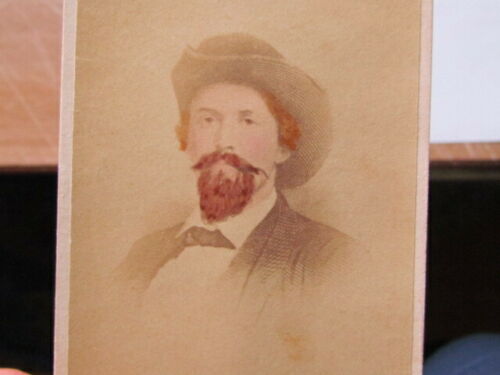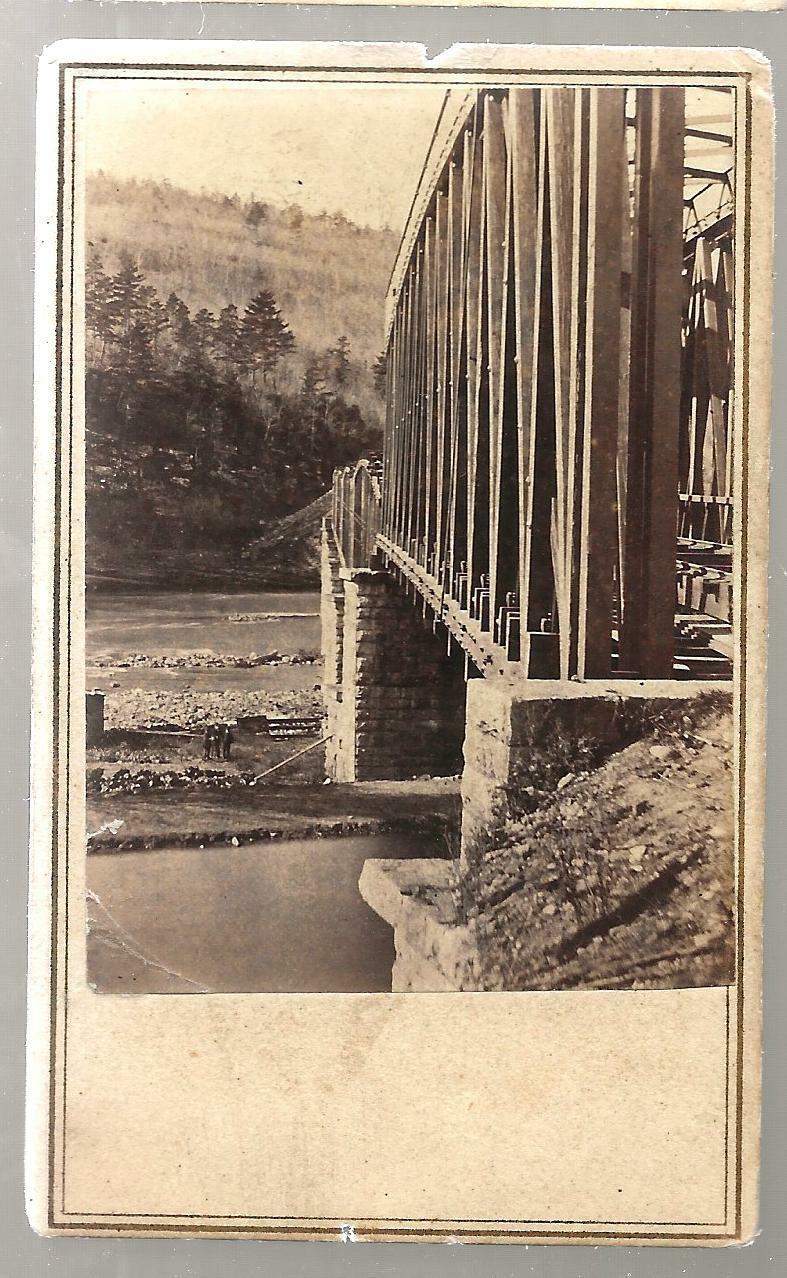-40%
1860s CIVIL WAR UNION NAVY ADMIRAL DAVID FARRAGUT CDV PHOTO BY MATHEW BRADY
$ 4.75
- Description
- Size Guide
Description
VERY rare and original, 1862 CDV Photograph of United States Navy Civil War Rear Admiral David G. Farragut by Mathew Brady.This fantastic, period, albumen Photograph measures approx. 2 1/8” by 3 1/4” and is mounted on its original, square corner, gold ruled CDV Card Mount (card measures approx 2 1/4" by 3 1/2"). There is an 1862 copyright slug below the image on the mount and the ount is printed on the reverse with the photographers mark of E. Anthony - the photograph was originally taken by Mathew Brady and published by Anthony. This wonderful, full length, standing portrait was taken in early 1862 with Farragut wearing the uniform of a Navy Flag Officer - the highest rank in the United States Navy at the time.
David Glasgow Farragut (July 5, 1801 – August 14, 1870) was a flag officer of the United States Navy during the American Civil War. He was the first rear admiral, vice admiral, and admiral in the United States Navy. He is remembered in popular culture for his order at the Battle of Mobile Bay, usually paraphrased: "Damn the torpedoes, full speed ahead!" by U.S. Navy tradition.
This rare and wonderful CDV Photograph is in very good condition. The Image itself is clean and crisp and exhibits sharp focus, strong contrast and rich, warm tonality. The Card Mount is sound and intact with light edge wear and light soiling.
A very rare and beautiful, 1860's CDV Photograph of United States Navy Rear Admiral David G. Farragut by Mathew Brady and a fantastic addition to any collection!!
Be sure to check out this sellers other auctions for a number of other, original Civil War Photographs which are also being offered for sale this week on eBay!!!
A Bit about Admiral David Glasgow Farragut :
Through the influence of Cmdr. David D. Porter (father of Civil war Admiral David Dixon Porter), who had adopted him, Farragut was commissioned a midshipman in the United States Navy on Dec 10, 1810, at the age of nine, and served under Porter during the War of 1812. A prize master by the age of 12 Farragut was promoted to lieutenant in 1822, commander in 1844 and captain in 1855. Farragut was wounded and captured during the cruise of the Essex by HMS Phoebe in Valparaiso Bay, Chile on March 28, 1814.
In 1853, Secretary of the Navy James C. Dobbin selected Commander David G. Farragut to create Mare Island Naval Shipyard. In August 1854, Farragut was called to Washington from his post as Assistant Inspector of Ordinance at Norfolk, Virginia. President Franklin Pierce congratulated Farragut on his naval career and the task he was to undertake. September 16, 1854, Commander Farragut commissioned the Mare Island Naval Yard at Vallejo, California. Mare Island became the port for ship repair on the West Coast. Captain Farragut left command of Mare Island, July 16, 1858. Farragut returned to a hero’s welcome at Mare Island, August 11, 1859.
Though living in Norfolk, Virginia, prior to the Civil War, he made it clear to all who knew him that he regarded secession as treason. Just before the war's outbreak he moved with his Southern-born wife to Hastings-on-Hudson, a small town just outside New York City. He offered his services to the Union but was initially given just a seat on the Naval Retirement Board. Offered a command for a special assignment by his foster brother David Dixon Porter, he initially hesitated upon learning the target might be Norfolk, as he had friends and relatives living there; he eventually accepted and was relieved to learn the target was New Orleans. Doubts were raised by the Navy about Farragut's loyalty to the Union because of his southern birth as well as that of Mrs. Farragut. Porter, however, argued on Farragut's behalf, and Farragut accepted for the major role of freeing New Orleans from Confederate control.
In command of the West Gulf Blockading Squadron, with his flag on the USS Hartford, in April 1862, after a heavy bombardment, he ran past Fort Jackson and Fort St. Philip and the Chalmette, Louisiana, batteries to take the city and port of New Orleans, Louisiana on April 29, a decisive event in the war. Congress honored him by creating for him the rank of rear admiral on July 16, 1862, a rank never before used in the U.S. Navy. Before this time, the American Navy had resisted the rank of admiral, preferring the term "flag officer", to separate it from the traditions of the European navies. Later that year he passed the batteries defending Vicksburg, Mississippi. Farragut had no real success at Vicksburg; one makeshift Confederate ironclad forced his flotilla of 38 ships to withdraw in July 1862.
While he was a very aggressive commander, Farragut was not always cooperative. At the Siege of Port Hudson the plan was that Farragut's flotilla would pass by the guns of the Confederate stronghold with the help of a diversionary land attack by the Army of the Gulf, commanded by General Nathaniel Banks, to commence at 8:00 am on March 15, 1863. Farragut unilaterally decided to move the timetable up to 9:00 pm on March 14, and initiated his run past the guns before Union ground forces were in position. By doing so, the uncoordinated attack allowed the Confederates to concentrate on Farragut's flotilla and inflict heavy damage on his warships.
Farragut's battle group was forced to retreat with only two ships able to pass the heavy cannon of the Confederate bastion. After surviving the gauntlet, Farragut played no further part in the battle for Port Hudson, and General Banks was left to continue the siege without advantage of naval support. The Union Army made two major attacks on the fort, and both were repulsed with heavy losses. Farragut's flotilla was splintered, yet was able to blockade the mouth of the Red River with the two remaining warships; he could not efficiently patrol the section of the Mississippi between Port Hudson and Vicksburg. Farragut's decision thus proved costly to the Union Navy and the Union Army, which suffered its highest casualty rate of the Civil War at Port Hudson. Vicksburg surrendered on July 4, 1863, leaving Port Hudson as the last remaining Confederate stronghold on the Mississippi River. General Banks accepted the surrender of the Confederate garrison at Port Hudson on July 9, 1863, ending the longest siege in US military history. Control of the Mississippi River was the centerpiece of Union strategy to win the war, and with the surrender of Port Hudson the Confederacy was now severed in two.
On August 5, 1864, Farragut won a great victory in the Battle of Mobile Bay. Mobile was then the Confederacy's last major port open on the Gulf of Mexico. The bay was heavily mined (tethered naval mines were known as torpedoes at the time). Farragut ordered his fleet to charge the bay. When the monitor USS Tecumseh struck a mine and sank, the others began to pull back. Farragut could see the ships pulling back from his high perch, lashed to the rigging of his flagship, the USS Hartford. "What's the trouble?" was shouted through a trumpet from the flagship to the USS Brooklyn. "Torpedoes!" was shouted back in reply. "Damn the torpedoes!" said Farragut, "Four bells. Captain Drayton, go ahead! Jouett, full speed!" The bulk of the fleet succeeded in entering the bay. Farragut then triumphed over the opposition of heavy batteries in Fort Morgan and Fort Gaines to defeat the squadron of Admiral Franklin Buchanan.
Farragut was promoted to vice admiral on December 21, 1864, and to admiral on July 25, 1866, after the war. His last active service was in command of the European Squadron from 1867 to 1868, with the screw frigate USS Franklin as his flagship. Farragut remained on active duty for life, an honor accorded to only six other US naval officers.
Click Here to Read More About the Life and Naval Service of Rear Admiral David G. Farragut.
Overseas shipping is extra and cost will be quoted at bidders request. Massachusetts residents must add 6.25% sales tax.
Please check out other early and interesting items offered by this seller on ebay.
Click Here to See Our Items We Have for Sale in the eBay Gallery
and
Click Here to Add Us To Your Favorite Sellers List.
Important Notes about Shipping Charges:
The amount quoted for Shipping & Handling is calculated by eBay and is equal to the EXACT amount charged by the Post Office plus a .00 "packing fee" - the .00 fee is our only compensation for the virgin packing materials we use on all of our professionally packaged boxes as well as our cost for the salaried help that does most of our packing - as I am sure you can see, we make NO profit on the Shipping charges and, in fact, our costs are usually greater than the .00 fee. Please contact us if there are any issues regarding the cost of shipping.
Powered by SixBit's eCommerce Solution
ATTENTION FRIENDS!!!
We are pleased to announce the start up of a second weekly auction by WALNUTTS-2.0!!!
The next generation of NUTS have decided to take a crack at listing some of the hundreds of items that we have accumulated over the past 38 years.
Click Here to See What WALNUTTS-2.0 is Offering in this week?s Ebay Auction!!
Rest assured that WALNUTTS2 will be offering the same high standard of customer service and 100% unconditional satisfaction guarantee that you have found here in our weekly auctions.
The "young'uns" will be starting off slow as they learn the ropes but we ask that you support them as you have supported us over the past 23+ years!!









